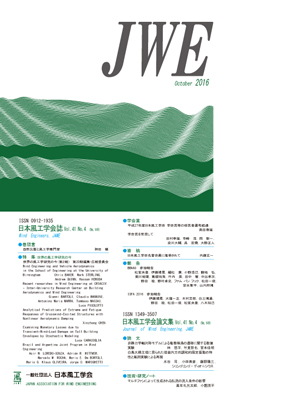All issues

Volume 41, Issue 4
[No. 149]
Displaying 1-3 of 3 articles from this issue
- |<
- <
- 1
- >
- >|
Technical Paper
-
Yuhei HAYASHI, Tetsuya TAKEMI, Yoshiaki MIYAMOTOArticle type: Tecnical Paper
2016Volume 41Issue 4 Pages 125-135
Published: October 31, 2016
Released on J-STAGE: March 01, 2017
JOURNAL FREE ACCESSThe transition of tornado-like vortices is numerically investigated with the use of a nonhydrostatic axisymmetric model. Tornado-like vortices are generated by imposing a specified external force along the central axis of the computational domain that is rotating at a constant angular velocity. When the vortex transition from one to two-celled structure occurs, there is an overshoot of the radial inflow near the surface. The overshooting flow turns upward, directing outward to a larger radius. At the same time, downdraft penetrates to the surface at the rotating axis. The overshoot is generated by coupled effects of inward advection and inward pressure gradient force. The downdraft is caused by downward pressure gradient.View full abstractDownload PDF (4597K) -
Tsukasa MIZUTANI, Toshihiko KOBAYASHI, Yozo FUJINO, Dionysius SIRINGOR ...Article type: Technical Paper
2016Volume 41Issue 4 Pages 136-147
Published: October 31, 2016
Released on J-STAGE: March 01, 2017
JOURNAL FREE ACCESSThis paper describes an along-wind vibration of frame-type pylons of Hakucho Suspension Bridge found from long-term vibration monitoring data. It is shown that the vibration is very harmonic although its amplitude is small and it occurs under certain ranges of wind direction (10~30 degree from the bridge perpendicular axis) and of wind velocity (13~25 m/s). The dominant frequency of the vibration is either 0.6 Hz or 0.8 Hz depending on the wind velocity and these correspond to the natural frequencies of the in-plane pylon dominant modes of the suspension bridge. A series of the wind tunnel experiments using a spring-supported scaled model are conducted under uniform flow and the along-wind pylon vibration was observed and its vibration characteristics is found to be consistent to those observed in Hakucho Bridge. It is also found that the vibration is very sensitive to the incident angle of wind and to the distance between the two columns.View full abstractDownload PDF (2831K)
Technical Note
-
Kotaro TAKAMURE, Shigehira OZONOArticle type: Technical Note
2016Volume 41Issue 4 Pages 148-151
Published: October 31, 2016
Released on J-STAGE: March 01, 2017
JOURNAL FREE ACCESSDownload PDF (1265K)
- |<
- <
- 1
- >
- >|